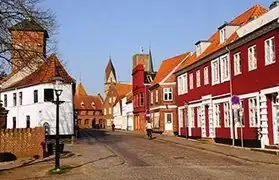Learn Danish for free
Learn Danish fast and easily with our language course ‘Danish for beginners’.
![en]() English (UK]
»
English (UK]
»
![da.png]() Dansk
Dansk
| Learn Danish - First words | ||
|---|---|---|
| Hi! | Hej! | |
| Hello! | Goddag! | |
| How are you? | Hvordan går det? | |
| Good bye! | På gensyn. | |
| See you soon! | Vi ses! | |
What is special about the Danish language?
The Danish language, with its melodious sound and rich history, holds a special place among the North Germanic languages. Spoken primarily in Denmark and parts of Greenland and the Faroe Islands, it connects its speakers to a heritage that dates back over a thousand years. This connection to the past is preserved through the language, making it a living piece of history. Danish pronunciation is particularly noteworthy for its softness and the use of stød, a glottal stop that is unique to the language. This feature can be challenging for learners but adds a distinctive rhythm and melody to spoken Danish. The presence of stød helps differentiate words that would otherwise be homonyms, enriching the language’s expressiveness.
The language’s vocabulary reflects Denmark’s history of trade, exploration, and cultural exchange. Danish includes words borrowed from Low German, English, French, and Norse, among others. This linguistic borrowing has created a diverse and adaptable vocabulary that continues to evolve. Danish grammar is characterized by its simplicity, especially when compared to other Germanic languages. The absence of cases for nouns and a more straightforward verb conjugation system make Danish relatively easier to learn for speakers of English and other Germanic languages.
In literature, Danish has a proud tradition that includes the works of Hans Christian Andersen, Søren Kierkegaard, and Karen Blixen. Through their writings, the depth of the Danish language is showcased, revealing its capacity for both poetic beauty and profound philosophical thought. Efforts to promote Danish culture and language are evident both within Denmark and internationally. Schools offer Danish language courses, and there are cultural exchanges that highlight the significance of the Danish language in global arts and literature.
The role of Danish in the digital age is also significant. Despite being spoken by a relatively small population, there is a strong presence of Danish content on the internet. This digital engagement ensures that the language adapts to new forms of communication and remains relevant. The specialness of the Danish language lies in its ability to unite its speakers with their history while continuously adapting to the present. It is a testament to the resilience and adaptability of Danish culture, embodying the spirit of a nation that values both its past and its future.
Even Danish beginners can learn Danish efficiently with ‘50LANGUAGES’ through the practical sentences. First you will get to know the basic structures of the language. Sample dialogues help you to express yourself in the foreign language. Prior knowledge is not required.
Even advanced learners can repeat and consolidate what they have learned. You learn correct and frequently spoken sentences and you can use them immediately. You will be able to communicate in everyday situations. Use your lunch break or time in traffic to learn a few minutes of Danish. You learn on the go as well as at home.
Learn for free...
Text book - book2 English - Danish for beginners Learn Danish - First words
Learn Danish with the Android and iPhone app ‘50LANGUAGES’
The Android or iPhone app ‘Learn 50 languages’ is ideal for all those who want to learn offline. The app is available for Android phones and tablets as well as iPhones and iPads. The apps include all 100 free lessons from the 50LANGUAGES Danish curriculum. All tests and games are included in the app. The MP3 audio files by 50LANGUAGES are a part of our Danish language course. Download all audios for free as MP3 files!








